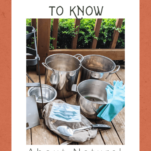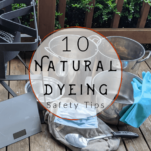This post contains affiliate links. I could be an affiliate for many different products, but I chose these specifically because they are the products and brands I like and recommend. By using my links, you help support this website.
Understanding natural dyeing safety is crucial for anyone venturing into the world of natural dyes. This guide provides insights and precautions to ensure a safe dyeing process.
Natural dyeing safety basics:
- Ensure Proper Ventilation: Always work in a well-ventilated space to avoid inhaling fumes or dust.
- Prioritize Personal Protection: Don protective gear, including masks and gloves, to safeguard against potential irritants.
- Maintain Separate Equipment: Never mix utensils used for dyeing with those for eating to prevent contamination.
- Stay Organized and Prepared: Familiarize yourself with each step of the dyeing process in advance to ensure smooth execution.
- Exercise Caution Near Heat: Be vigilant around heat sources to prevent burns and fire hazards.
- Practice Good Hygiene: Always wash your hands thoroughly after handling dyes to prevent skin irritation and potential ingestion.
Guide to natural dyeing safety
Are you diving into natural dyeing?
There are a few safety things you’ll want to keep in mind. Messing with powders, mordants, and hot water can get tricky if you’re not careful.
Let’s break down some safety tips for natural dyeing.
Some are just good ol’ common sense, while others might need a bit of planning ahead.
If you prefer to watch than read, I made a video on Natural Dye Safety:
Natural dyeing safety
Working with powders
When working with powdered dyes, mordants, assistants and other dyeing powders wear a dust mask and consider wearing safety glasses.
Breathing any kind of powder is not good for your health, even if it is “natural.”
Also, work in an area that doesn’t have a breeze going through it. Powders blowing around as you are measuring them out is frustrating and more likely to cause you to breathe them in.

Some links below are referral links, meaning, at no extra cost to you, we earn a commission if you make a purchase. Thank you for supporting Textile Indie in this way! See our complete disclosure statement.
Ventilation
While you don’t want a breeze through your work area when measuring powdered dyes and mordants, good air filtration is essential for other aspects of the dyeing process. For instance, when you’re extracting dye over a heat source and anytime you have anything on the stove.
Working outdoors is a great option if you have a cookstove or an outdoor burner.
If you are working indoors, turn on the stove fan, set up an additional fan in the kitchen, and open a window to allow fresh air.
All of this fresh air will help push smells and steam outside.
Separate equipment
Use separate pots and equipment for natural dyeing. You don’t want to dye and cook meals with the same kitchenware.
While many natural dye raw materials are not harmful – and may even be edible – mordants, poisonous plant parts, and inedible plants could cause health issues if cross-contaminated.
Store your dye equipment away from your cooking equipment.
Clearly label everything with “dye” or another label that identifies it.

Prepare questionable dyes outside
Again, working outside is a great way to eliminate fumes and moisture in the house. If you are using a plant with a strong smell and are unsure about its toxicity, I highly recommend going through the dye process outside.

Protective gear for natural dyeing safety
Dress like a scientist!
Good protective gear will go a long way in eliminating potential health risks and injuries.
Wear a dust mask
Always wear a dust mask when measuring mordants, powdered dye, and concentrates. The particles get in the air, into your lungs, and can cause respiratory problems.
Once the powders are stirred into the water, they will not blow in the air. Whether you wear the dust mask throughout the heating process is your discretion.

Wear rubber gloves
When working with mordant baths, wear gloves and thoroughly wash your hands or skin whenever the mordant bath splashes onto you.
I have never had any skin reaction to alum or iron water, and I’ve had my bare hands in the bath to grab bundles of fiber quickly.
But I would not suggest this as a regular practice. You could have a skin reaction, and exposing yourself to metal salts is not a good idea.
Wearing gloves to remove dyed fiber from dye baths, especially with very potent dye baths, will keep your hands from changing color.
Wear an apron
To protect your clothes, wear a waterproof apron.
Be prepared for each step
Have all your materials laid out and prepared. Avoid scrambling to find a cloth or equipment by thinking through the process beforehand.

Wash your skin whenever you get splashed with dye
When dyeing, there is a high likelihood that you will get splashed with dye liquid.
Wear old clothes or a waterproof apron to avoid ruining your nice clothing.
Also, dye liquid is often scalding – if not boiling. Be aware and cautious when working around your dye pots.

Working with heat
Be aware of heat source safety. Working with burners, stoves, boiling water, and dye baths requires common sense and caution.
Natural dyeing safety equipment
What to do with your mordant and dye baths when you’re done
Disposing of mordant baths safely
When you have completed using a mordant or dye bath, you need to dispose of it.
For mordant baths with alum or iron (or other metal mordants), dispose of the bath by dumping the excess water onto gravel or another location away from the soil.
The mordants in the water make it toxic enough that you wouldn’t want to water your veggie garden with it.
Another option is to further strip the mordant bath of the mordant salts to make it less toxic to the environment. In other words, exhaust the mordant bath.
To exhaust the mordant bath, use it a second time.
Don’t add more mordant; add more fiber and bring up the heat. Follow the mordant procedure for your type of fiber.
Then, after you have removed the second batch of fiber, you can dispose of the water outdoors. There will be little mordant left in the water, decreasing its toxicity.

Disposing of dye baths safely
Natural dye baths are typically non-toxic and can be emptied down the drain.
I often dump mine in my flower garden.
I avoid my vegetable garden and other edible plants as an extra precaution. It’s probably fine, but I have plenty of ornamentals to water.













